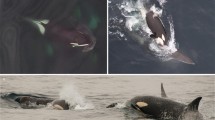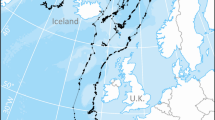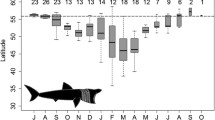Abstract
During January/February 2006, we satellite-tracked two different ecotypes of killer whales (Orcinus orca) in McMurdo Sound, Ross Sea, Antarctica, using surface-mounted tags attached with sub-dermal darts. A single Type B whale (pinniped prey specialist), tracked for 27 days, traveled an average net distance of 56.8 ± 32.8 km day−1, a maximum of 114 km day−1, and covered an estimated area of 49,351 km2. It spent several days near two large emperor penguin (Aptenodytes forsteri) colonies, a potential prey item for this form. By contrast, four Type C killer whales (fish prey specialists) tracked for 7–65 days, traveled an average net distance of 20 ± 8.3 km day−1, a maximum of 56 net km day−1, and covered an estimated area of only 5,223 km2. These movement patterns are consistent with those of killer whale ecotypes in the eastern North Pacific where mammal-eating ‘transients’ travel widely and are less predictable in their movements, and fish-eating ‘residents’ have a more localized distribution and more predictable occurrence, at least during the summer months.



Similar content being viewed by others
References
Andrews RD, Mazzuca L, Matkin CO (2005) Satellite tracking of killer whales. In: Loughlin TR, Calkins DG, Atkinson S (eds) Synopsis of Research on Steller Sea Lions: 2001–2005. Alaska SeaLife Center, Seward, pp 238–248
Baird RW (2000) The killer whale: foraging specializations and group hunting. In: Mann J, Connor RC, Tyack PL, Whitehead H (eds) Cetacean societies. University of Chicago Press, Chicago, pp 127–153
Ballard G, Ainley D (2005) Killer whale harassment of Adélie penguins at Ross Island. Antarct Sci 17:385–386
Barber-Meyer SM, Kooyman GL, Ponganis PJ (2008) Trends in western Ross Sea emperor penguin chick abundances and their relationships to climate. Antarct Sci 20:3–11
Barrett-Lennard LG, Ford JKB, Heise KA (1996) The mixed blessing of echolocation: differences in sonar use by fish-eating and mammal-eating killer whales. Anim Behav 51:553–565
Berzin AA, Vladimirov VL (1983) A new species of killer whale (Cetacea, Delphinidae) from Antarctic waters [in Russian]. Zool Zhurnal 62(2):287–295
Bigg MA (1982) An assessment of killer whale (Orcinus orca) stocks off Vancouver Island, British Columbia. Rep Int Whal Comm 32:655–666
Burns JM, Castellini MA, Testa JW (1999) Movements and diving behaviour of weaned Weddell seal (Leptonychotes weddellii) pups. Polar Biol 21:23–36
Condy PR, Van Aarde RJ, Bester MN (1978) The seasonal occurrence and behavior of killer whales Orcinus orca, at Marion Island. J Zool Lond 184:449–464
Curran MAJ, van Ommen TD, Morgan VI, Phillips KL, Palmer AS (2003) Ice core evidence for Antarctic sea ice decline since the 1950 s. Science 302:1203–1206
Deecke VB, Slater PJ, Ford JKB (2002) Selective habituation shapes acoustic predator recognition in harbour seals. Nature 420:171–173
Deecke VB, Ford JKB, Slater PJB (2005) The vocal behavior of mammal-eating killer whales: communicating with costly calls. Anim Behav 69:395–405
Douglas D (2007) The Douglas Argos-Filter. Accessed 1 October 2007. http://alaska.usgs.gov/science/biology/spatial/manual.html
Elwen S, Meyer MA, Best PB, Kotze PGH, Thornton M, Swanson S (2006) Range and movements of female Heaviside’s dolphins (Cephalorhynchus heavisidii), as determined by satellite-linked telemetry. J Mammal 87:866–877
Ford JKB, Ellis GM, Barrett-Lennard L, Morton AB, Palm R, Balcomb KC (1998) Dietary specialization in two sympatric populations of killer whales (Orcinus orca) in coastal British Columbia and adjacent waters. Can J Zool 76:1456–1471
Ford JKB, Ellis GM, Balcomb KC (2000) Killer whales: the natural history and genealogy of Orcinus orca in British Columbia and Washington State. UBC Press, Vancouver
Geertsen BM, Teilmann RA, Kastelein HNJ, Vlemmix HNJ, Miller LA (2004) Behaviour and physiological effects of transmitter attachments on a captive harbour porpoise (Phocoena phocoena). J Cetacean Res Manag 6:139–146
Guinet C (1992) Comportement de chasse des orques (Orcinus orca) autour des îles Crozet. Can J Zool 70:1656–1667
Guinet C, Bouvier J (1995) Development of intentional stranding hunting techniques in killer whale (Orcinus orca) calves at Crozet Archipelago. Can J Zool 73:27–33
Guinet C, Domenici P, de Stephanis R, Barrett-Lennard L, Ford JKB, Verborgh P (2007) Killer whale predation on bluefin tuna: exploring the hypothesis of the endurance-exhaustion technique. Mar Ecol Prog Ser 347:111–119
Hooge PN, Eichenlaub B (2000) Animal movement extension to Arcview. ver. 2.0. Alaska Science Center, Biological Science Office, US Geological Survey, Anchorage
Jenouvrier S, Barbraud C, Weimerskirch H (2006) Sea ice affects the population dynamics of Adelie penguins in Terre Adelie. Polar Biol 29:413–423
Jones IM (2006) A northeast Pacific offshore killer whale (Orcinus orca) feeding on a Pacific halibut (Hippoglossus stenolepis). Mar Mamm Sci 22:198–200
Kasamatsu F, Joyce GG (1995) Current status of odontocetes in the Antarctic. Antarct Sci 7(4):365–379
Kooyman GL, Kooyman TG, Horning M, Kooyman CA (1996) Penguin dispersal after fledging. Nature 383:397
Kooyman GL, Hunke EC, Ackley SF, van Dam RP, Robertson G (2000) Moult of the emperor penguin: travel, location, and habitat selection. Mar Ecol Prog Ser 204:269–277
Krahn MM, Pitman RL, Burrows DG, Herman DP, Pearce RW (2008) Use of chemical tracers to assess diet and persistent organic pollutants in Antarctic Type C killer whales. Mar Mamm Sci 24(3):643–663
La Mesa M, Eastman JT, Vacchi M (2004) The role of notothenioid fish in the food web of the Ross Sea shelf waters: a review. Polar Biol 27:321–338
Lauriano G, Fortuna CM, Vacchi M (2007) Observation of killer whale (Orcinus orca) possibly eating penguins in Terra Nova Bay, Antarctica. Antarct Sci 19:95–96
LeDuc RG, Robertson KM, Pitman RL (2008) Mitochondrial sequence divergence among Antarctic killer whale ecotypes is consistent with multiple species. Biol Lett 4:426–429
Mikhalev YAM, Ivashin V, Savusin VP, Zelenaya FE (1981) The distribution and biology of killer whales in the Southern Hemisphere. Rep Int Whal Comm 31:551–566
Morton AB (1990) A quantitative comparison of the behaviour of resident and transient forms of the killer whale off the central British Columbia coast. Rep Int Whal Comm (Spec Issue) 12:245–248
Pitman RL, Ensor P (2003) Three forms of killer whales in Antarctic waters. J Cetacean Res Manag 5:131–139
Pitman RL, Perryman WL, LeRoi D, Eilers E (2007) A dwarf form of killer whale in Antarctica. J Mammal 88:43–48
Shevchenko VI (1975) Karakter vzaimootnoshenii kasatok i drugikh kitoobraznykh. Morsk Mlekopitayushchie Chast’ 2:173–175 [Translated in 1976 as “The nature of interrelationships between killer whales and other cetaceans” by the Translation Bureau (WRI), St. Anne de Bellevue, Multilingual Services Division, Department of the Secretary of the State of Canada, Translation Series 3839]
Similä T, Holst JC, Øien N, Hanson B (2001) Satellite and radiotracking study of movements of killer whales in the wintering grounds of herring in Norway. European Cetacean Society, annual meeting, Rome 5–10.5.2001
Smith TG, Siniff DB, Reichle R, Stone S (1981) Coordinated behaviour of killer whales, Orcinus orca, hunting a crabeater seal, Lobodon carcinophagus. Can J Zool 59:1185–1189
Stewart BS, Yochem PK, Gelatt TS, Siniff DB (2000) First-year movements of Weddell seal pups in the western Ross Sea, Antarctica. In: Davison W, Howard-Williams C (eds) Antarctic ecosystems: models for wider ecological understanding. Caxton Press, Christchurch, pp 71–76
Stewart BS, Yochem PK, Gelatt TS, Siniff DB (2003) The pack ice niche of Weddell seals in the Ross Sea. In: Huiskes AHL, Gieskes WWC, Rozema J, Schorno RML, Van Der Vies SM, Wolff WJ (eds) Antarctic biology in a global context. Backhuys Publishers, Leiden, pp 224–228
Visser IN (1999) Antarctic orca in New Zealand waters? N Z J Mar Freshwater Res 33:515–520
Visser IN, Smith TG, Bullock ID, Green GD, Carlsson OGL, Imberti S (2008) Antarctic Peninsula killer whales (Orcinus orca) hunt seals and a penguin on floating ice. Mar Mamm Sci 24:225–234
Wilson B, Dill LM (2002) Pacific herring respond to simulated odontocete echolocation sounds. Can J Fish Aquat Sci 59:542–553
Acknowledgments
Our research was supported by grants from National Science Foundation (OPP-0338428), National Geographic Society, and US Marine Mammal Commission, was approved by the Alaska SeaLife Center Institutional Animal Care and Use Committee (03-006), and was conducted under NOAA Fisheries Office of Protected Resources permit #782–1719 and Antarctic Conservation Act permit 2004-009 M#2. We thank TJ Moore at SWFSC for GIS support and all those at NSF, Raytheon, and McMurdo Station that made this work possible, especially J Walker and the helicopter pilots and crews of Petroleum Helicopters International. Development of satellite transmitters was funded by grants from NOAA and the US Fish & Wildlife Service to the Alaska SeaLife Center and was dependent upon help from R Hill, T Rupley and others at Wildlife Computers, as well as C Matkin, B Hanson, S Norberg, B Barrie, and V Aderholt. D Ainley provided observations in McMurdo Sound.
Author information
Authors and Affiliations
Corresponding author
Rights and permissions
About this article
Cite this article
Andrews, R.D., Pitman, R.L. & Ballance, L.T. Satellite tracking reveals distinct movement patterns for Type B and Type C killer whales in the southern Ross Sea, Antarctica. Polar Biol 31, 1461–1468 (2008). https://doi.org/10.1007/s00300-008-0487-z
Received:
Revised:
Accepted:
Published:
Issue Date:
DOI: https://doi.org/10.1007/s00300-008-0487-z




